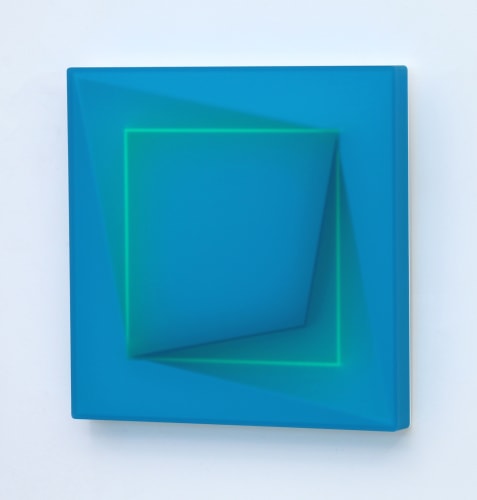Kāryn Taylor (b.1969 Aotearoa, New Zealand) manipulates materials, light, form and shadow to challenge our perception of the structures that ground our reality. Her practice is informed by geometric abstraction, which stems from her interest in quantum physics.
Kāryn produces self-illuminating light boxes and multi-dimensional installations. The light boxes are intense in colour, with their glowing lines of light that defy logic. They are analogue, glowing without power. Their illumination is striking; convincing many that there must be some kind of hidden mechanism or light source.
Language can be viewed as a logical system of written, signed or spoken words, with which we communicate and express ourselves. Taylor’s practice and exhibition concepts, touch on the intersection between scientific knowledge and language. Taylor uses form, colour and light to optically suggest a new descriptive language of the universe. She is interested in how this language might hold specific frequencies that bypass the mind, allowing us to subliminally take in information.
In 2023 Taylor presented the solo exhibition, Future Philosophies at The Suter Art Gallery Te Aratoi o Whakatū, Nelson. Utilising geometric abstraction and installation, the artist offered questions concerning space, time and what we consider as tangible reality.
“The question that reverberates behind Taylor’s artworks and is suggested in her artwork titles, is: how are we, our worlds, time and space, consciousness – and perception, connected? This is neither detached philosophising nor ‘dry’ science for Taylor. It is both personal and universal in implication.”
- Kyla Mackenzie, Curator, The Suter Art Gallery Te Aratoi o Whakatū, June 2023
The artist was a finalist in the Fulbright Wallace Award, Parkin Drawing Prize, the Waikato Contemporary Art Award and the Lola Anne Tunbridge Award. Taylor’s works are held in numerous private and public collections, both nationally and internationally including; The Suter Art Gallery Te Aratoi o Whakatū, Nelson; Justin Art House Museum, Melbourne and the ACU Art Collection, Sydney. She lives and works in Māpua, Nelson.
